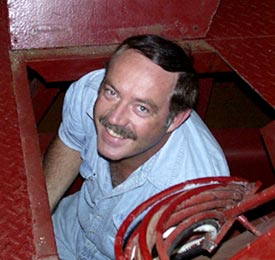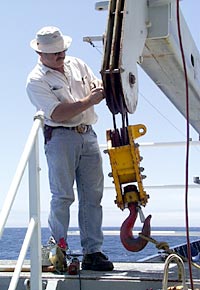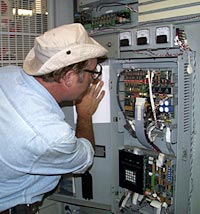Galápagos Islands
Expedition 5:
Aug 23-Sep 24, 2001
Mission & Objectives
Daily Updates
Mail Buoy
Scientists & Crew
Interviews
Hot Topics
Slideshows
Videos
Activities
Glossary
|
Interviews: Marine Electrician Alden “Big Al” Luallin
 Emerging from the forward bilge, Alden checks out a false alarm. Emerging from the forward bilge, Alden checks out a false alarm.
Al Luallin first become interested in electronics when he
was in junior high school. He and a friend began a project to build
a submarine that would work in his friend's swimming pool. “It
was 1971 and that was my first trip to Radio Shack,” he says.
“We went to the one in Van Nuys, Calif., to get parts for the
sub.” They bought flashlight batteries, a plastic housing and
a fan motor to run the toy submarine, wrapped it in plastic and tape
to make it waterproof and varied its buoyancy with weight. “We
had a lot of fun watching it motor around the bottom of the pool,
but we had to play with its buoyancy a bit to keep it down there.”
His friend also taught Al how to play an electric guitar. But Al was
more excited about the electrical connections that made the guitar
work than learning how to play. “You have to adjust the controls
in order to get the right sound out of the amplifier. And the connections
really interested me. I started toying around with two-way radios
and walky-talkies.”
 |
 |
| Big Al checks the block on the starboard crane. |
Al
took electronics as an elective in high school as well as chemistry. “We learned about the components of a circuit and experimented
with light bulbs, switches, batteries and resistors.” At 18 years
old, Al joined the Navy as an interior communications electrician
working the shipboard intercoms, alarms, navigational aids and telephones.
That’s when Al first crossed the equator and earned his shellback
certificate.
Until sailors cross the equator they are considered pollywogs, like
frogs are called tadpoles before they develop legs. King Neptune,
usually the captain of the ship, hosts an equator crossing ceremony
where the pollywogs go through a right of passage. A shellback refers
to the hard shell on the back of a turtle. Once sailors have a shellback
certification card, the next time they cross the equator they can
sit with King Neptune and his throne. Most of the ceremony consists
of good-natured jokes and skits.
“I was 19 and heading to Australia on a West Pacific cruise
out of Hawaii,” Al says. “The day prior to our initiation
was pollywog day, we sneaked up on shellbacks and scared them with
buckets of water, soap, or food. The next day the shellbacks woke
us up at sunrise and took us through a variety of tasks. It was warm
weather, but windy, and we were wet, cold and sticky.”
 |
 |
| Checking over the electronics board of the port engine. |
During the second leg of that cruise, Al traveled to Hong Kong, where
he met his wife, Casimera. “After I became a shellback, we left
Australia and went to Hong Kong. We were so ready to get off the ship
and hungry, the first thing we did was head straight to a McDonald’s
restaurant. There were four of us and we ran into four women who were
also eating lunch at McDonald’s, so we all talked and ate together.
Casimera was one of the women. She worked as a domestic housekeeper
in Hong Kong and is from the Philippines. We were in Hong Kong for
three days and when we left Casimera and I kept in touch through letters
and phone calls for two years. She then flew to the United States
and we’ve been married now 21 years. I have three children: Alicia
is 10, Chris is 17 and Regina is 19. Casimera works as an electrical
assembler with Northrup Grumman in Sorrento Valley, Calif.”
Al left the Navy after nine years and began working with the National
Steel and Ship Building Co. or NASSCO in San Diego where he and his
family live. “Everyone had a nickname embroidered on their jumpsuit
and mine was Big Al,” he says. “We would prepare a new ship
and take it out to sea to demonstrate its capabilities to the owners,
usually the Navy.” The chief engineer of each ship would ask
“Big Al” to join the crew as a merchant marine since he
was already knowledgeable about the electronic equipment on board.
This year Al decided he would give it a try. “I took a course
in maritime safety and that’s when I learned about SCRIPPS.” The RV Revelle is his first trip as a Merchant Marine. SCRIPPS
hired Al in June of 2001 and in July he flew to Costa Rica to meet
Revelle.
 |
 |
| Alden,
in his workshop on-board RV Revelle. |
 |
“The people are great. I’ve been familiarizing myself with the
electronic equipment as I go. I repair and troubleshoot all the electrical
and electronic systems, such as the fire detectors, safety and warning
alarms, telephones and public announcement systems, power and lighting
and propulsion and auxiliary controls and interfaces.” Big Al
is finding the expedition extremely exciting, “The scenery is
fantastic and the dredging and MR1 surveying is an intriguing process.
You’re reaching so deep into the ocean floor and pulling up interesting
scientific items. I’ve never seen an expedition to dredge up lava
and study them. You don’t know what each piece might be like until
you see it.”
|

 Emerging from the forward bilge, Alden checks out a false alarm.
Emerging from the forward bilge, Alden checks out a false alarm.

